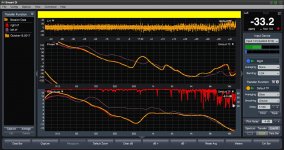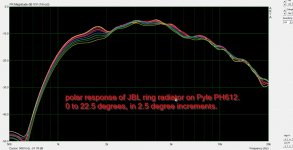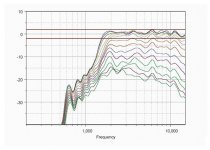You can read almost anything on psychoacoustics to find about this. It's been studied over decades. Jim Griffin's studies doesn't recant thousand of other researchers....And without sources to show your well studied and proved point of view.
Again.... can you hear it, or can it just be measured.
I respond to proof. I don’t do well with authoritative viewpoints with people I never heard of using anonymous internet names.
Not to mention all who have experienced this. The difference going from a lot of high gain reflections to strongly attenuated ones (especially early reflections) isn't something subtle. It's a night a day difference! Try a few broadband absorbers placed in first reflection points and you'll notice this is easily. 🙂
But can one hear it with program material, not pink noise and specially selected music designed to show what you want?
This is a very good point, and why I usually use program material. But we also know that results vary, sometimes greatly, with program material, so that's a big complication. But here are the facts: there are things that I can measure that cannot be heard on any program material, there are things that I can measure that cannot be heard on some program material, but I have not yet encountered a situation where people can reliably hear something that I cannot measure.
What this means is that great measurements are a necessary requirement to great sound, hence, one should always start with how things measure and if the measurements show problems then there is likely a problem. But one can also overkill a system with doing too much - correcting problems that aren't audible. Sorting this out has been my life's work, I'd think that you would appreciate feedback from what I know.
I have watched people with advanced degrees in electrical engineering argue with you[/B]
We are not arguing EE, I'm not a EE, my Degree is in Theoretical Physics, and my specialty is acoustics and psycho-acoustics, which is precisely what we are arguing about.
I am a basic DIYer without much mathematical knowledge. I build for my own ears and brain. And I have. I have the equipment to do measuring but I never used it because my ears and brain worked much better.
I am not selling speakers to anyone. I am not in the business. If it can be described as astounding using Pictures at an Exhibition as an example, then I may include it into my current design.
I leave the technical mathematical stuff to people for whom it is their life’s work. I want to have what it sounds like described to me, not what it measures like.
LOWMASS DID WHAT ALL THE SMART HIGHLY EDUCATED ENGINEERS HERE DID NOT DO.
I am not selling speakers to anyone. I am not in the business. If it can be described as astounding using Pictures at an Exhibition as an example, then I may include it into my current design.
I leave the technical mathematical stuff to people for whom it is their life’s work. I want to have what it sounds like described to me, not what it measures like.
LOWMASS DID WHAT ALL THE SMART HIGHLY EDUCATED ENGINEERS HERE DID NOT DO.
We are not arguing EE, I'm not a EE, my Degree is in Theoretical Physics, and my specialty is acoustics and psycho-acoustics, which is precisely what we are arguing about.
GOOD FOR YOU! I love physics. My son has one of those in Experimental Nuclear Physics. He has as much difficulty explaining what he knows in real life terms as you do.
MOVING ON. Everyone keeps humming the same tune over and over---I think its a Bartok Quartet.
It FYI not FIY - you really do need to reread your posts!FIY:
But I see no point in sharing anything more with a person with your attitude. You overlook basic understanding and show no humility in wanting to learn.
I see the situation the same way.
Interesting.
In the car audio world, during the last 10-20 years people have gone nuts with DSP. A typical car audio system in 2018 has a midrange and tweeter that are as much as 1-2 feet apart, and they use DSP to hammer everything into shape.
The end result is an incredible soundstage; I'd argue that a typical car audio system in 2018 images better than a home system. (Because the DSP allows you to fine tune everything to the nth degree.[/B]
This is interesting. I haven't been into car audio in 35 years but had an experience once that showed the sound stage potential that apparently has been realized today.
My friend had a simple system in his car. philips 6 inch 2 way in rear with two philips tweeters up on front dash. ADS amp and Concord tape deck. It was colored but always sounded quite spacious for a car. Anyway one day we were just driving along with "Slowride" by Foghat playing over radio. All of a sudden out of nowhere there was possibly the most stable and solidly palpable image I have ever heard in any system car or home. The 2 gitars were absolutely solidly placed in space about 5 feet outside the car in front left and right. I was genuinely speechless and after about 5 seconds of this my friend, without any indication from me started to slow down and pull over. Looking at me he said " are you hearing this!?". He was hearing it too. It lasted for about 10 more seconds then just vanished. It was a cloudy day and we were under a bridge. Some strange effect ??
One of the interesting things in Lidia and my study is that we get almost completely opposite results depending on the signal used. If one uses noise then image is not affected at all but the coloration is severe. If one uses impulse then the image is affected but there is little coloration.
My speakers image great and have great tonality. What's not to like!
The size 😉
But seriously, I'm hopefully moving into a place that's bigger than a shoebox soon. I'm looking forward to having room for decent speakers.
We are not arguing EE, I'm not a EE, my Degree is in Theoretical Physics, and my specialty is acoustics and psycho-acoustics, which is precisely what we are arguing about.
I was an art major. I *really* like making things in 3D, and it's particularly fun when it's challenging. That's one of the reasons I've 3D printed so many waveguides, and I've blown a lot of time reverse-engineering the JBL patents.
But here's the funny part:
At the end of the day, the big QSC waveguide, which is basically oblate spheroidal, is tough to beat. I remember when the M2 waveguide first came out, you wrote: "In horn designs, it has always appeared to me that the more outrageous one makes the device look while maintaining some reasonable performance it can then be claimed to be "new" or "revolutionary" and even patented. But there is simply not much new in this realm and none of these "new" devices works any better than the older ones."(1)
It took me years of studying and reverse engineering, but I'm about *this* close to agreeing. I probably could've saved myself a lot of trouble and just made an OS waveguide lol.
But again, it's an "art" thing, I like 3D design.
Just putting that out there, because some people probably assume that I'm bonkers and Unity Horns are my white whale. But the truth is mostly that I like to build crap. If I wasn't doing waveguides I'd probably be drawing comic books or something like that. If I was making loudspeakers for a living, my designs would be a lot less crazy.
(1) JBL horn?
I was an art major. I *really* like making things ...
I gave up making speakers to make art. If you haven't seen my work on my website you should.
Just putting that out there, because some people probably assume that I'm bonkers and Unity Horns are my white whale. <snip>
Can you save me a lot of time and just tell me straight away which waveguide/horn (exact model) is best, regardless of size? 🙂 (speaking as someone who might build wg-speakers one day)
The problem with 3D printing horns is that it's too expensive at the moment to do it with large horns. Personally I've no interest in horns that needs to be crossed over at 800 Hz or higher. With those sizes, there are other designs that are better IMO. CBT is one, and which several step above whether the CBT is built with wide or narrow horizontal dispersion (both can be done) IMO. I've done the comparison.
Large horns are great though. Getting the cross over down to 600 Hz and constant directivity lower in frequency makes a huge difference.
I've done the comparison.
So have I and my opinion is the opposite of yours. We are looking for different things I guess.
I gave up making speakers to make art. If you haven't seen my work on my website you should.
I saw that a few weeks ago. Nice work!
In-car you really need to watch EQ thru fingers. Dual channel FFT helps a lot rather than just measuring distances. There is lot going on, theres different slopes, maybe mixed if different amps.In the car audio world, during the last 10-20 years people have gone nuts with DSP. <snip>
For basics i take close measurements from high and mid, eq applied, minimal to none eq to drivers seat

example, you really cant eq that 500hz cancellation
Can you save me a lot of time and just tell me straight away which waveguide/horn (exact model) is best, regardless of size? 🙂 (speaking as someone who might build wg-speakers one day)


I like the JBL progressive transition waveguides quite a bit. First measurement above is a measurement that I did with that waveguide and a JBL 2408H-1. That's the same compression driver that JBL uses in their commercial designs, so if you don't feel like DIY'ing it, you could get very good performance by simply buying their speaker imho. I've heard the newer waveguide/CD combos are even better. Check out the JBL 705 and 708.
The 2nd measurement above is one that Geddes did of the same waveguide but with a Selenium D220ti compression driver. Geddes included CD EQ with his measurement, I didn't.
I don't remember doing that and to my knowledge I have never had a Selenium D220ti. Could it be something else? That format of data is very very old > 12 years, so maybe I forgot.
I like the JBL progressive transition waveguides quite a bit. <snip>
Thanks! Much appreciated.
How did you reach this conclusion without doing any measurements?I have the equipment to do measuring but I never used it because my ears and brain worked much better.
I think what he is saying is the classic audiophile mantra "I don't care how it measures, I know what I like.", which is one point of view. However, it doesn't translate very well since it is a personal point of view and opinion that gives us no reason to believe that any others of us would also find the same result. Of course that may not matter to him.
- Status
- Not open for further replies.
- Home
- Loudspeakers
- Multi-Way
- Floor-to-ceiling array vs CBT